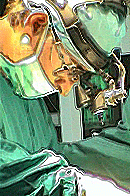X-Ray Films of the Skull
 Skull films were once the
mainstay of initial diagnostic imaging of a patient with a
suspected intracranial mass, but are no longer necessary in the
majority of cases. Some abnormalities that affect the appearance
of the skull base or calvarium, such as hyperostosis secondary
to a meningioma or bone remodelling from a slowly growing tumor,
may be seen on x-ray films but are better detected with CT.
Furthermore, the extent of involvement is more precisely defined
using CT, particularly at the skull base. Intracranial
calcification is also shown with greater sensitivity and more
precise localization using CT.
Skull films were once the
mainstay of initial diagnostic imaging of a patient with a
suspected intracranial mass, but are no longer necessary in the
majority of cases. Some abnormalities that affect the appearance
of the skull base or calvarium, such as hyperostosis secondary
to a meningioma or bone remodelling from a slowly growing tumor,
may be seen on x-ray films but are better detected with CT.
Furthermore, the extent of involvement is more precisely defined
using CT, particularly at the skull base. Intracranial
calcification is also shown with greater sensitivity and more
precise localization using CT.
High-resolution CT should
always be used in instances where conventional x-ray tomography
would have been considered previously. CT provides better
definition of bone and soft tissue along specific anatomic
planes and it allows better definition of small anatomic
structures such as skull base foramina and temporal bone
anatomy. Additionally, CT exposes the patient to much lower
doses of radiation when compared to x-ray tomography.
When an overview of skull
anatomy is needed for planning an operative approach, in most
cases the lateral scout image of the skull obtained at the time
of CT together with the axial CT bone images provide all of the
information that is needed. Only in a small minority of cases is
skull imaging of value preoperatively.
Skull films have declined
markedly in importance and have now been relegated to a
secondary diagnostic technique in the work-up of patients with
intracranial tumors. The reasons for this change are many.
First, literature reviews in large series of patients have shown
that skull films obtained in patients who present with symptoms
suggestive of an intracranial abnormality demonstrate findings
related to the intracranial pathology in only a small
percentage of cases. In a selected group of 136 patients with
proven intracranial tumor, only 17.6 percent showed positive
findings on plain radiography of the skull. Second, the
findings seen on skull films are all indirect findings
associated with a mass that can be directly visualized with CT.
Third, bony changes in the skull base and calvarium,
intracranial calcification, and midline shift are all better
evaluated with CT. Finally, and probably most compelling, any
patient presenting with symptoms suggesting an intracranial
neoplasm will still require CT or MRI regardless of the skull
film findings.
Nevertheless, it is important
to recognize skull film abnormalities suggestive of an
intracranial mass, because they are occasionally seen on skull
films obtained for unrelated reasons. Such findings include
demineralization of the dorsum sellae secondary to increased
intracranial pressure, cranial hyperostosis, bone erosion,
abnormal intracranial calcification, and midline shift of a
calcified pineal gland.


